by Winding Pathways | Jan 15, 2015 | Nature
A showy winter sight is deep orange to scarlet bittersweet berries dusted by snow. Often they are picked for holiday decorations.
Parts of North America are home to two wild bittersweets. One is a beautiful native that’s in rapid decline. The other is a fast spreading exotic that overwhelms even large trees.
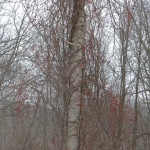
Bittersweet can wrap around and smother a tree.
Oriental bittersweet is an aggressive twining vine that can climb a 60 foot tree and smother its foliage. The woody vine is sometimes upwards of four inches in diameter at its base. Oriental bittersweet thrives in open woods that allow sunlight to filter to the forest floor. It grows amazingly fast and produces yellow berries along the vine that split open to reveal scarlet fruits. The plant has bright green leaves are roundish.
In contrast, American bittersweet is neither invasive nor aggressive. Its leaves are oblong, and it produces flowers and fruits at the end of its vine. But, telling the difference between native and Oriental bittersweet is difficult. Buying at nurseries is not recommended.
Aggressive Oriental bittersweet hybridizes with and outcompetes its American relative. Unfortunately, the foreign species is becoming common as the native retreats.
Controlling Oriental bittersweet isn’t easy. Vines can be cut with shears or a hand saw. Small vines can be pulled from the ground, but rootlets remaining in the soil will sprout. Some herbicides will kill it.
People can help contain this aggressive plant by recognizing the difference between the American and Oriental species and not moving the seeds of the latter or using them for decorations.
by Winding Pathways | Jan 13, 2015 | Nature
People often tell us that they regularly see does and fawns in their neighborhood but hardly ever see a buck. “Where are they?” they ask.
Deer thrive in suburban and urban areas throughout the country. Although does are often seen, sighting antlered bucks is rare. Even massive ones with wide spreading antlers have the uncanny ability to stay out of sight in the midst of the city.
The best evidence of big bucks is a shed antler. Male deer begin growing them in early spring. By September they are full size and are used through the fall for sparring with other males and to bang against trees. Often the mere size of a buck’s antlers intimidates smaller rivals.
A male fawn is called a button buck and its antlers are tiny stubs that rarely protrude above the hair. For the next four or five years his antlers will be bigger every year but as the buck reaches old age his new antlers decrease in size each year.
Antlers are firmly attached the skull, but by late December the bond begins to weaken. Sometime between Christmas and late March they fall off the deer’s head, and for a short while the animal is antlerless. Most antlers drop in February and March, but usually the largest bucks drop theirs in late December and January.
Antlers are mostly composed of calcium. Rodents love chewing on them and recycle the minerals into their own bodies. By summer most shed antlers are gone.
Hunting sheds is a popular mid to late winter hobby. Some homeowners are lucky enough to discover one in the back yard, but usually it takes a search through an area with a high deer population. Predicting where sheds will be is difficult but often they are near a ravine or fence where the deer jumped. The slight jarring during a jump causes the antlers to drop off. Best shed hunting happens right after the snow melts in late winter. Shed antlers are usually white and get buried in fluffy snow. As soon as it melts they are visible from a longer distance. Binoculars can help find one.
So “Shed” your mid-winter blues, bundle up the kids and go outside on a deer “shed search.”
by Winding Pathways | Jan 12, 2015 | (Sub)Urban Homesteading, Energy Efficiency, Nature, Preparedness
People have the good fortune to sit in a warm home watching birds glean seeds outdoors in winter’s frigid weather. It is amazing that they remain active in temperatures that cause human frostbite after just minutes of exposure.
Birds have several adaptations that enable them to function in extreme cold. Perhaps most important is being clothed in highly efficient insulators – feathers. Even in our era of modern high tech insulation, goose down quilts and coats are warmer than any synthetic insulation, so the hundreds of feathers covering small birds keep them warm.
Birds have a high metabolism that produces toasty body heat but requires huge quantities of fuel. They must eat often and spend much of the day foraging. To fight the cold they devour high calorie foods such as weed seeds and frozen insects. But beef suet and sunflower seeds stocked in bird feeders also help keep them warm.
During extreme cold birds often overnight in the security of a dead tree. Tiny birds snugly pass howling blizzards tucked into small crevices. Wood is a relatively efficient insulator and birds squeeze between the bark and wood or in holes excavated by woodpeckers. Bird houses erected in spring to attract nesting wrens or bluebirds serve double duty as safe roosting sites.
Unfortunately winter is the season of death for many birds and other small wild animals. Cold, wind, snow, lack of food and predators take their toll and only a fortunate small percentage of young wild animals live until their first birthday.
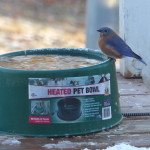
This winter we have seen as many as four male and one female bluebirds at one time at our “dogfeeder” waterer.
During the winter provide plenty of seed and suet for the birds. And, remember that critical element – water!
Homeowners can help birds safely winter by protecting dead trees and erecting bird houses before cold weather arrives. Put the latter on your list to do this spring and give the birds a hand for next winter.
by Winding Pathways | Jan 6, 2015 | Birds, Nature
Step out the back door this winter and scan the sky. You might spot our national bird soaring overhead.
A few decades ago eagle populations had been decimated by DDT poisoning and odds of spotting an eagle in Iowa were long. That’s changed as eagles began increasing in the 1990’s across the country. Although still not abundant, they are increasingly common in both rural and urban areas.
Eagles aren’t shy and don’t seem to mind being around people. They sometimes even nest inside city limits, usually in a large tree near water and cruise over neighborhoods in their search for food.
Winter is the most likely season to spot an eagle. During summer months some nest in warm states but more fly north to raise their young along remote lakes and streams in Minnesota, upper New England and Canada. When those northern lakes ice over in late fall eagles gradually move south until they find open water and plenty of fish. Dams create turbulence and factories sometimes discharge warm water that keep water open in otherwise frozen rivers. Eagles love these places and concentrate there, often even in the downtown of large cities.
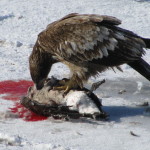
Eagles will dine roadside on carcasses.
Eagles enjoy eating fish but also feast on deer killed by cars and nearly any dead animal they can find. Don’t be surprised to see one on the edge of a highway having a venison breakfast.
Mature bald eagles of both genders have characteristic white tails and heads. When soaring at high elevation white feathers are nearly invisible against the sky and the bird looks headless and tailless.
Young bald eagles are nearly as big as their parents but their tails and heads are dark. White feathers don’t form until they are three or four years old. A high percentage of young birds are a sign of successful reproduction and a growing population.
by Winding Pathways | Dec 29, 2014 | Mammals, Nature
Every winter the residents of urbanized areas are astonished to spot massively antlered buck deer in broad daylight. These large animals haven’t just moved to town. They’ve been here all along. Unlike does and fawns, bucks are exceedingly secretive and are rarely spotted as they hide in tiny urban wooded areas and even prairies. However, during the main mating season in November and a secondary one in December bucks lose their caution and may be spotted in even the most urban areas. Also, all deer are more visible in winter than summer because leaves have dropped and snow covers the ground.
Sometimes an area’s largest bucks reside in towns for a number of reasons. Often cities have nutritious food interspersed with woods and ravines that provide secluded hiding places. Hunters usually prefer to shoot large bucks, and in rural areas these often become steaks and chops before they fully mature. Most city bucks are well nourished and, provided they survive highway collisions, are more likely to live longer and grow bigger antlers than their rural cousins.Well-nourished five and six year old bucks normally have the largest antlers but beyond these years their antlers decline as part of the aging process.
Today many cities allow bow hunting to trim deer damage to vegetation and reduce vehicle collisions. Usually hunters are required to shoot does, which allows urban bucks grow old and large.
Every year, usually in March or April but sometimes as early as December, bucks shed their antlers. By late April they begin growing new ones. So, the very large antlerless deer spotted in late winter could be a buck. Hunting shed antlers in late winter is becoming a popular activity.
Although big bucks live near people all year, winter is a great season to observe them.
by Winding Pathways | Dec 16, 2014 | Nature, Travel/Columns, Trees/Shrubs
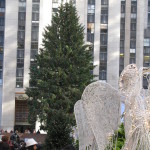
Rockefeller Center is the site of an amazing Christmas Tree that overlooks the skating rink in NYC.
Although increasing numbers of Americans are opting for an artificial Christmas tree, millions enjoy bringing a real tree into their homes for the festive season. As the fashions wax and wane, we see an upsurge in families eagerly venturing out to tree farms to select and cut a real tree. Many species of evergreens are used for Christmas trees but the following species are by far the most common:
EASTERN WHITE PINE: This is the great pine of New England and the upper Lake States that was logged to near oblivion in the late 1800s. It can grow to over 200 feet tall. Thankfully many survived and today the white pines are often used for Christmas Trees in the East. The natural range of the Eastern White Pine is from Southern Canada down to the Mid-Atlantic states and west to about Iowa. It has been widely planted outside its native range and a similar species, the Western White Pine, lives in northern Idaho and nearby Montana and Washington. White pines grow relatively rapidly and have five long soft needles in a bunch.
SCOTS (or Scotch) PINE: This fast growing but usually short lived tree has become increasingly popular as a Christmas tree. They are usually cut when only five or six feet tall, making them ideal for smaller houses and apartments. The species is native to Europe and is the most widespread pine in the world. It has several subspecies. Scots pine has two short twisted and somewhat stiff needles per bundle. On large trees the upper trunk bark is sometimes bright orange.
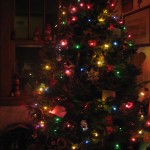
The soft glow of lights on a cold winter’s night warms our hearts.
BALSAM AND FRASER FIRS: This traditional Eastern tree is native to the cool moist north woods. Widespread in upper New England and Eastern Canada its range extends south along the Appalachian Mountains and west to Iowa. One of the slower growing conifers it has the wonderful evergreen fragrance that many people associate with Christmas. A similar tree, called the Fraser Fir, looks almost the same but the underside of its needles is silvery. It is native to the southern Appalachians. Both the Balsam and Fraser Firs have very short needles. These are by far favored Christmas Trees in the North East and along the East Coast.
OTHERS: Ponderosa pines and Douglas Firs are native to many western states and are often used for Christmas trees. A smattering of other pine, spruce, and fir species are also occasionally used.
In the East most people purchase a tree, but out west it’s more common for a family to make an outing to cut a wild tree. Occasionally, a family will bring a cedar, arbor vitae, or even a dried tumbleweed home to decorate as a Christmas “tree”.





